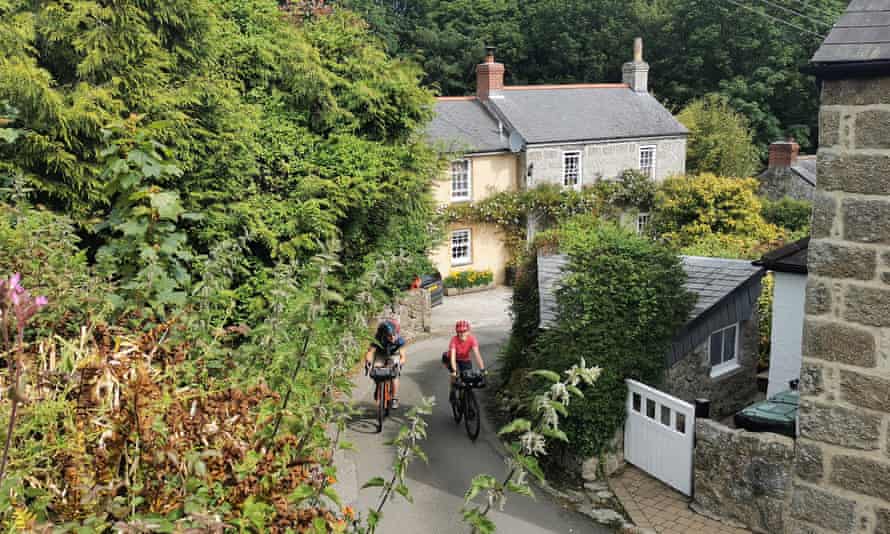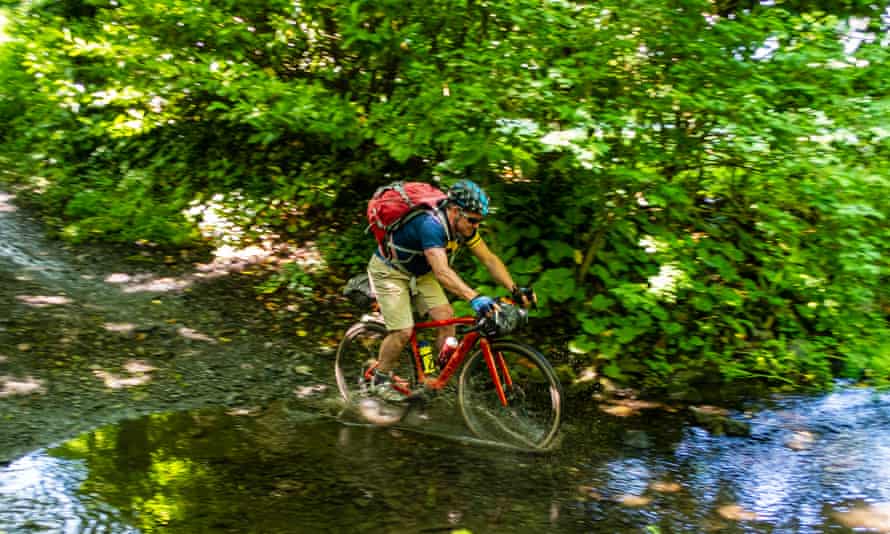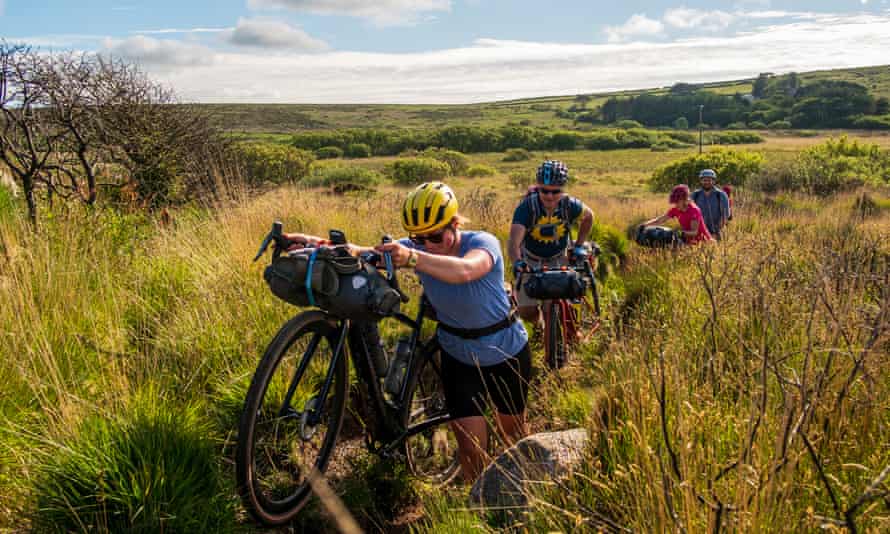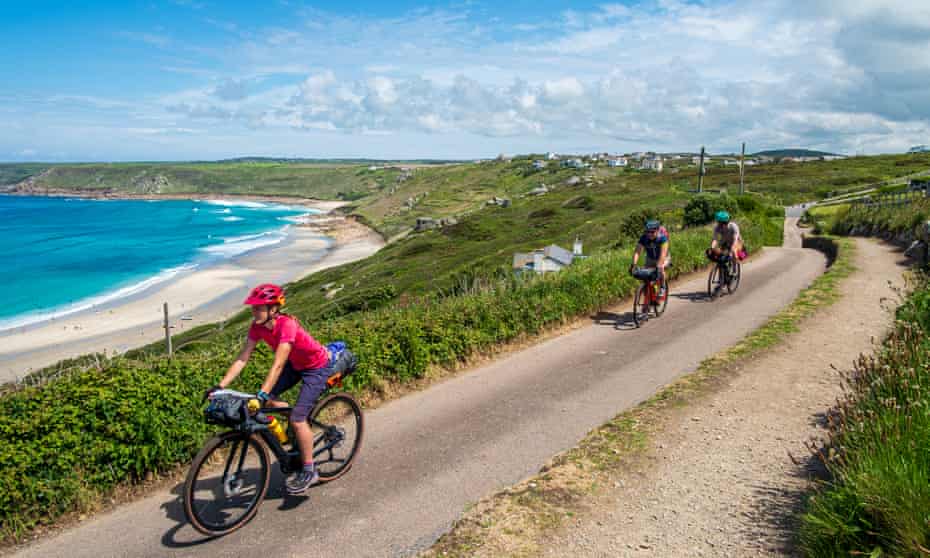I had never hoisted my leg over an e-bike for a multiday tour before, but when someone offered to lend me one – an elegant lightweight gravel bike with an internal battery – to ride a new bikepacking route in deepest Cornwall, I didn’t hesitate. Many will relish riding the 200km West Kernow Way, which loops round the Penwith and Lizard peninsulas, with muscle power alone, but for me, now in my fifth decade of cycling, the electric assistance rendered pleasures that far outweighed the ragging from my children when I got home.
It is difficult to think of another part of Britain that packs such a variety of landscapes into such a small area. On the Penwith peninsula, we cycled past granite cliffs, the great beach at Whitesand Bay, high barren moors, rolling dairy farmland and steep-sided, narrow valleys lush with ferns. On the Lizard peninsula, there were thickly wooded creeks, plant-rich downlands and picturesque coves from the pages of a Daphne du Maurier novel. The penultimate section of the route, which starts and finishes in Penzance, follows abandoned mining tramways: formerly used to transport ore from the industrial spine of Cornwall around Redruth and Camborne to the coast, they have been repurposed as excellent gravel cycle paths.

Choosing the right type of bike for a ride that mixes tarmac and trails over such varied terrain is not straightforward. Hardtail mountain bikes (with just front suspension) and gravel or “adventure” bikes generally fare best. As anyone who has cycled around the south-west will know, though, Cornwall is hilly. In fact, the topography here is uniquely defined by short but very steep climbs, particularly in and out of the sheltered bays like Cadgwith and Coverack on the Lizard. But these can be made light of with an electric bike.
The West Kernow Way has been developed by Cycling UK and Cornwall county council, with EU funding. The route is not signposted, so you need a GPS device, Neither is it perfect – there are sections of rarely used, heavily overgrown (at least in summer) bridleways, and lengths of technical, rutted singletrack that I had to walk my steed through. These are minor failings, though, and anyway we should be grateful to Cycling UK: the West Kernow Way is the latest addition to an expanding list of long-distance, predominantly off-road routes that the organisation has helped configure, including the Great North Trail and King Alfred’s Way.

Cycling UK, formerly known as the Cyclists’ Touring Club, has been campaigning for cyclists to be able to use rights of way – roads at first, and in more recent decades, bridleways – since 1878. They have taken a radical approach this time: several segments of the West Kernow Way are designated as footpaths, or at least they are “incorrectly recorded on the map as footpaths”, according to Cycling UK, whhich cites historical map evidence that they were previously used by horses and vehicles. These “lost ways” can be restored through legal measures (definitive map modification orders or DMMOs, if you must know) but the process takes years, even decades. Far better, Cycling UK insists, that we start using these “lost ways” now. Some cyclists will balk at riding on footpaths; others will relish such quiet acts of trespass. For everyone, though, riding the West Kernow Way is an opportunity to reflect on the inflexibility of the rights of way system in England and Wales, where 78% of the network is off-limits for cycling.

Many well-known landmarks are included in the West Kernow Way – Land’s End, Sennen Cove, Cape Cornwall, the Mên-an-Tol standing stones, Lizard Point, the Helford River and Saint Michael’s Mount – but many people will probably already have visited them. More enchanting, for me, were the unexpected encounters with land and sea: carpets of bright pink sea thrift folding into rocky coves; streaks of white spume entwined round promontories in the blue-black sea; stone barns with roofs covered in orange lichen; sod banks stacked with corridors of campion, foxgloves and stitchwort; wind-bowed trees and sunsets that went on for ever.
Endurance cyclists will inevitably attempt the entire West Kernow Way in one go. Most people will break it down into three or four days, lingering beside the route on headlands and in pub gardens, swimming in the sea and picnicking beside neolithic cairns. We rode the route over three days in June, carrying our gear in bikepacking bags which took a good rattling, but did a better job than a rack and panniers. We camped in a farmer’s field one night, and in a bell tent beside the youth hostel in Coverack the next. The route has been developed with the aspiration of attracting cyclists to Cornwall through the “shoulder” months of September, October, March and April, when camping may not be so appealing. There are plenty of accommodation providers at hand, but planning will be key.

Fortunately, there are villages and cafes near the route, so we didn’t carry cooking gear. Instead, we ate excellent fish and chips from Fraser’s on the promenade in Penzance, pasties the size of rugby balls in Portleven, mussels in the Paris Hotel overlooking the sea in Coverack and a delicious brunch at the Slice of Cornwall cafe in the woods near Constantine. One lunchtime, we treated ourselves to a foraged lunch of seaweed miso, black mustard sushi and nettle cupcakes, all prepared to order and served beside the sea by Caroline Davey from the Fat Hen on the way to Land’s End.
As the roads became busier with holidaymakers in June, this route whistles you away from visitor honeypots in a trice. We skipped the jams in St Just and were quickly on the glorious gravel path that winds through abandoned copper and tin mines round Botallack Head; we exchanged the heaving lunchtime crowd in Porthleven for the peace of the strand at Loe Bar; and we left the busy banks of the Helford river behind to ride alone on farm tracks over Butteriss Downs to Stithians reservoir.

Riding through this Cornish backcountry allowed us to savour not just the landscape, but the distinct soundscapes too: the squalling cries of jackdaws early in the morning; the wind keening through blackthorn thickets; the liquid song of skylarks on the moors in the heat of the afternoon; and the repetitive boom of Atlantic combers folding on shingle beaches – sounds that remained with me long after I had finished the ride, reluctantly returned the electric bike and journeyed north, away from this magical land.
A guidebook to the West Kernow Way and GPX files of the route will be available from Cycling UK in early September. The Tour of Britain cycle race starts in Penzance on 5 September
Rob Penn is the author of Slow Rise: A Bread-Making Adventure (Penguin, £17.99)





